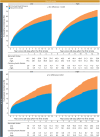Genetic Risk and Prognosis of the First Incident Stroke Survivors: Findings from China Kadoorie Biobank and UK Biobank
- PMID: 40577674
- PMCID: PMC12205741
- DOI: 10.1212/WNL.0000000000213832
Genetic Risk and Prognosis of the First Incident Stroke Survivors: Findings from China Kadoorie Biobank and UK Biobank
Abstract
Background and objectives: Stroke is known for its poor prognosis. Although genetic instruments have shown promise in stratifying first stroke risk in the general population, it is unknown whether they are associated with stroke prognosis. Our study aims to explore the role of genetic risk of stroke in the progression from stroke-free to first stroke and then to recurrent stroke, subsequent coronary heart disease (CHD), and death in China and the United Kingdom.
Methods: We used data from 2 prospective population-based cohorts, China Kadoorie Biobank (CKB) and UK Biobank (UKB). Participants who were unrelated and free of stroke and CHD at baseline were included. Genetic risks of stroke were quantified using integrative polygenic risk scores (iPRSs), which incorporated summary statistics from multiple genome-wide association studies for stroke outcomes and its subtypes, and vascular-risk traits. We used a multistate model to analyze the roles of genetic risk in the transitions from baseline to first incident stroke and then to recurrent stroke, subsequent CHD, and death.
Results: Our study included 80,908 CKB participants and 380,348 UKB participants, with mean ages (% female) of 54.0 years (58.6%) and 56.1 years (55.4%). During median follow-ups of 11.9 years and 13.4 years in the CKB and UKB, respectively, 13,481 and 5,772 participants had their first stroke, neither experienced a CHD, or died within 28 days. These survivors had 5,707 and 943 recurrent strokes, as well as 1,196 and 418 CHD events, respectively. iPRSs were associated with recurrent stroke and CHD among stroke survivors in both populations. The corresponding hazard ratios (HRs) and 95% CIs per SD of iPRSs were 1.08 (1.05-1.11) and 1.08 (1.02-1.15) in CKB and 1.11 (1.03-1.19) and 1.23 (1.10-1.37) in UKB, respectively. There was no association between iPRSs and mortality risk. When we further divided the first stroke into 4 pathologic subtypes, both populations revealed statistically significant associations between iPRSs and the transitions from first ischemic stroke to recurrent stroke and CHD.
Discussion: Our study shows that the genetic risk of first stroke also influences the prognosis of stroke survivors, indicating that PRS has the potential to improve stroke prognosis.
Conflict of interest statement
The authors report no relevant disclosures. Go to
Figures





Similar articles
-
Smoking cessation for secondary prevention of cardiovascular disease.Cochrane Database Syst Rev. 2022 Aug 8;8(8):CD014936. doi: 10.1002/14651858.CD014936.pub2. Cochrane Database Syst Rev. 2022. PMID: 35938889 Free PMC article.
-
Associations of different insulin resistance-related indices with the incidence and progression trajectory of cardiometabolic multimorbidity: a prospective cohort study from UK biobank.Cardiovasc Diabetol. 2025 Jun 18;24(1):257. doi: 10.1186/s12933-025-02819-0. Cardiovasc Diabetol. 2025. PMID: 40533754 Free PMC article.
-
Causal Relevance of Lp(a) for Coronary Heart Disease and Stroke Types in East Asian and European Ancestry Populations: A Mendelian Randomization Study.Circulation. 2025 Jun 17;151(24):1699-1711. doi: 10.1161/CIRCULATIONAHA.124.072086. Epub 2025 Apr 29. Circulation. 2025. PMID: 40297899 Free PMC article.
-
Signs and symptoms to determine if a patient presenting in primary care or hospital outpatient settings has COVID-19.Cochrane Database Syst Rev. 2022 May 20;5(5):CD013665. doi: 10.1002/14651858.CD013665.pub3. Cochrane Database Syst Rev. 2022. PMID: 35593186 Free PMC article.
-
Effects of a gluten-reduced or gluten-free diet for the primary prevention of cardiovascular disease.Cochrane Database Syst Rev. 2022 Feb 24;2(2):CD013556. doi: 10.1002/14651858.CD013556.pub2. Cochrane Database Syst Rev. 2022. PMID: 35199850 Free PMC article.
References
-
- Stroke and Transient Ischaemic Attack in over 16s: Diagnosis and Initial Management [Internet]. National Institute for Health and Care Excellence (NICE); 2022. ncbi.nlm.nih.gov/books/NBK542436/ - PubMed
MeSH terms
LinkOut - more resources
Full Text Sources
Medical
Research Materials
Miscellaneous
